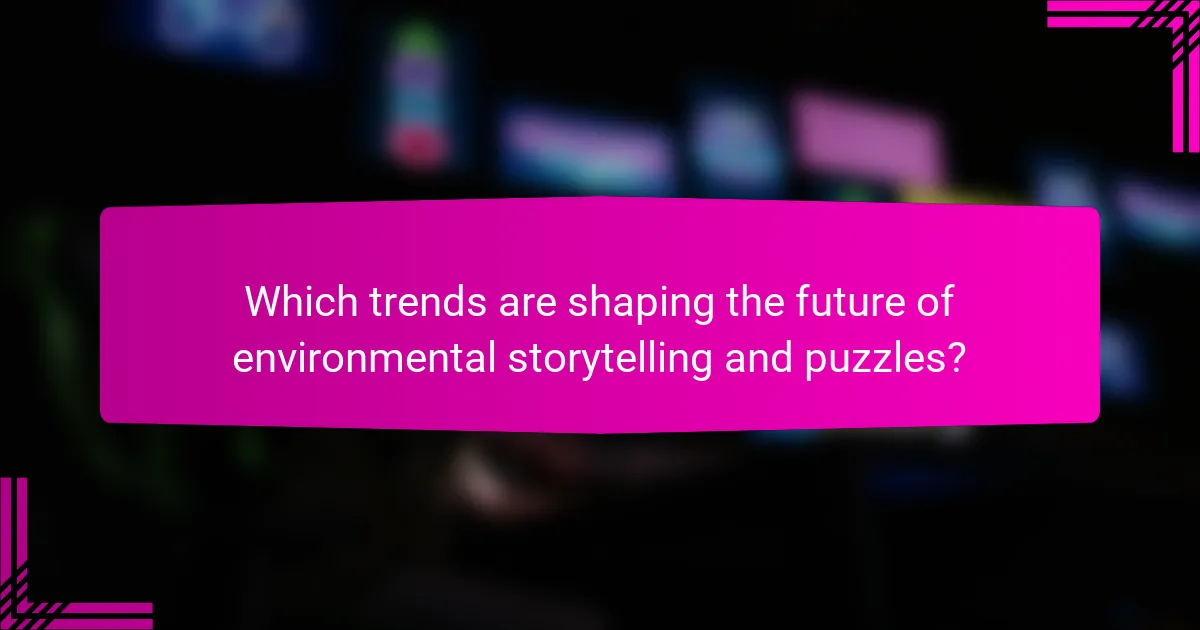Environmental storytelling, puzzles, and player immersion are key elements that enhance gaming experiences. This article explores how environmental storytelling fosters emotional connections, the role of puzzles in promoting critical thinking, and the impact of sound design and visuals on immersion. It also addresses challenges in balancing these elements and examines trends such as immersive technology and sustainability in gaming.

How does environmental storytelling enhance player immersion?
Environmental storytelling significantly enhances player immersion by creating a rich, interactive world that conveys narrative through the environment itself. This technique fosters emotional connections as players discover clues and details that reveal backstory and character motivations. The use of visual cues, sound design, and spatial arrangement deepens engagement, encouraging exploration and interaction. Unique environmental elements, such as hidden areas or intricate puzzles, further enhance this experience, making players feel invested in the game’s universe. As a result, the immersive quality of gameplay is elevated, leading to a more memorable and impactful experience.
What are the core principles of environmental storytelling?
The core principles of environmental storytelling are immersion, context, and interaction. Immersion creates a believable world, allowing players to engage deeply. Context provides background and meaning, enriching the narrative. Interaction enables players to influence the environment, enhancing their connection to the story.
Which techniques are most effective in creating immersive environments?
Environmental storytelling, puzzles, and player immersion are highly effective techniques for creating immersive environments. These methods engage players by integrating narrative elements, interactive challenges, and emotional connections.
Environmental storytelling uses visual cues and design elements to convey a story without dialogue. This approach allows players to discover the narrative organically, enhancing their engagement.
Puzzles serve to challenge players while reinforcing the game’s themes. They require critical thinking, fostering a sense of accomplishment and deeper involvement in the game world.
Player immersion is achieved through sensory experiences, including sound design and visual aesthetics. Creating a cohesive atmosphere encourages players to lose themselves in the environment, enhancing overall enjoyment.
How do visuals and sound contribute to storytelling?
Visuals and sound significantly enhance storytelling by creating immersive experiences. They engage players emotionally and cognitively, fostering deeper connections to the narrative.
Visual elements, such as detailed environments and character designs, provide context and atmosphere. They convey emotions and themes, making the story more relatable. Sound effects and music further amplify this effect, influencing mood and pacing. For example, ambient sounds can immerse players in a setting, while a powerful score can heighten tension during key moments.
Together, these sensory elements enrich the storytelling experience, making it more compelling and memorable. This integration of visuals and sound is crucial for environmental storytelling, puzzles, and overall player immersion.

What role do puzzles play in player engagement?
Puzzles significantly enhance player engagement by promoting critical thinking and problem-solving. They create immersive experiences that encourage exploration and interaction within the game environment. Engaging puzzles can lead to increased satisfaction and a sense of accomplishment, reinforcing players’ emotional investment in the game. Additionally, well-designed puzzles contribute to environmental storytelling by integrating narrative elements that deepen players’ connection to the game world.
How can puzzles be designed to complement the narrative?
Puzzles can enhance narrative by integrating clues that reveal story elements. They should reflect the game’s themes, encouraging players to engage deeply with the plot.
1. Align puzzles with character development to reinforce emotional connections.
2. Use environmental storytelling to provide context, creating immersive experiences.
3. Design puzzles that require players to explore and interact with the game world, unveiling narrative layers.
4. Incorporate unique puzzle mechanics that mirror plot twists, enhancing surprise and engagement.
What types of puzzles are most popular in immersive games?
The most popular types of puzzles in immersive games include environmental puzzles, logic puzzles, and narrative-driven puzzles. Environmental puzzles often require players to interact with the game world to uncover hidden paths or items. Logic puzzles challenge players to solve riddles or complete sequences using critical thinking. Narrative-driven puzzles integrate story elements, enhancing player immersion and engagement. Each type contributes uniquely to the overall gaming experience, fostering deeper connections to the game’s environment and storyline.
How do difficulty levels affect player experience with puzzles?
Difficulty levels significantly shape player experience with puzzles by influencing engagement and satisfaction. Higher difficulty can enhance the sense of achievement, while lower difficulty may lead to frustration or boredom.
Players often seek challenges that match their skill levels. When puzzles are too easy, players may feel unfulfilled; conversely, overly challenging puzzles can result in disengagement. Balancing difficulty fosters a rewarding experience that encourages exploration and problem-solving.
Effective puzzle design incorporates feedback mechanisms. These allow players to gauge their progress and adjust strategies, enhancing immersion. As a result, well-calibrated difficulty levels contribute to a more enjoyable and memorable gameplay experience.

Which unique attributes define the game ‘Inside’?
The game “Inside” is defined by its unique attributes of atmospheric environmental storytelling, intricate puzzles, and deep player immersion. These elements create a compelling experience that engages players emotionally and intellectually.
Inside employs a minimalist art style, enhancing its atmospheric storytelling. The narrative unfolds without dialogue, relying on visuals and environmental cues. This unique approach allows players to interpret the story personally, fostering a deeper connection to the game world.
The puzzles in Inside are cleverly designed, integrating seamlessly with the narrative and environment. Each puzzle challenges players to think critically and adapt to the game’s mechanics, maintaining engagement throughout.
Player immersion is heightened through the game’s sound design and visual aesthetics. The haunting soundtrack and dynamic visuals create an emotional landscape that draws players deeper into the experience, making the game’s themes resonate on a personal level.
What narrative techniques set ‘Inside’ apart from other titles?
‘Inside’ stands out through its innovative use of environmental storytelling, intricate puzzles, and deep player immersion. The game creates a rich narrative without dialogue, relying on visuals and sound to convey emotions and themes. This approach allows players to interpret the story uniquely, enhancing engagement. Additionally, the seamless integration of puzzles into the environment fosters a sense of exploration, making each discovery feel meaningful. The atmospheric design and attention to detail further immerse players, distinguishing ‘Inside’ from other titles in the genre.
How does the art style influence player perception?
The art style significantly shapes player perception by enhancing immersion and emotional engagement. A unique visual aesthetic can communicate themes and narratives without explicit dialogue. For instance, the use of color palettes can evoke specific moods, while environmental details can hint at backstory, enriching the player’s experience. This environmental storytelling engages players, prompting them to explore and interpret the game world actively. The art style thus serves as a critical tool in creating a memorable and impactful gaming experience.

What are common challenges in achieving player immersion?
Achieving player immersion often faces challenges such as environmental storytelling coherence, puzzle complexity, and player engagement. Environmental storytelling can struggle with clarity, making it hard for players to connect with the narrative. Puzzles may be overly complex or too simplistic, disrupting flow and engagement. Additionally, distractions in the game environment can break immersion, leading to disengagement. Balancing these elements is crucial for creating a fully immersive experience.
How do technical limitations impact storytelling and puzzles?
Technical limitations can restrict storytelling and puzzles by constraining narrative depth and player interaction. Limited graphics or processing power may hinder immersive environments, reducing emotional engagement. Additionally, simplistic puzzle mechanics can diminish challenge, impacting player satisfaction. These constraints can lead to a less dynamic experience, affecting overall player immersion.
What player behaviors can hinder immersion?
Player behaviors that hinder immersion include distraction, lack of engagement, and poor communication. Distractions such as multitasking can break focus and reduce the emotional connection to the game. Lack of engagement occurs when players do not invest in the story or characters, leading to a superficial experience. Poor communication among players can disrupt teamwork and diminish the shared narrative experience. These behaviors collectively detract from the intended immersive atmosphere of the game.

Which trends are shaping the future of environmental storytelling and puzzles?
Environmental storytelling and puzzles are increasingly shaped by immersive technology, player agency, and sustainability themes. These trends enhance engagement and emotional connection, driving innovative experiences.
The integration of virtual reality (VR) and augmented reality (AR) allows players to explore narratives in dynamic environments. As a result, storytelling becomes more interactive, fostering deeper immersion.
Player agency is another significant trend. Games increasingly allow players to make choices that influence outcomes, enhancing the sense of ownership and investment in the narrative. This shift encourages players to engage with environmental themes meaningfully.
Sustainability is also gaining prominence. Developers incorporate eco-conscious narratives and puzzles that challenge players to consider their impact on the environment. This trend not only entertains but also educates, promoting awareness of ecological issues.
How are emerging technologies influencing game design?
Emerging technologies significantly enhance game design by enabling advanced environmental storytelling, complex puzzles, and deeper player immersion. These innovations allow developers to create dynamic worlds that respond to player actions, enriching narrative experiences.
For instance, virtual reality (VR) technology immerses players in environments that feel tangible, enhancing emotional connections to the story. Additionally, artificial intelligence (AI) facilitates adaptive puzzles that evolve based on player behavior, increasing engagement and challenge.
Moreover, augmented reality (AR) blends real-world elements with game environments, creating interactive storytelling experiences that blur the lines between fiction and reality. This integration fosters a unique attribute in game design, where player agency directly influences narrative outcomes, resulting in personalized gameplay.
As a result, these technologies are reshaping the gaming landscape, pushing the boundaries of creativity and player interaction.
What role does player feedback play in evolving game mechanics?
Player feedback is crucial for evolving game mechanics as it directly influences design adjustments. Developers analyze player input to enhance environmental storytelling, refine puzzles, and boost immersion. This iterative process ensures that gameplay aligns with player expectations and enhances overall experience. Engaging players through feedback fosters a dynamic relationship, allowing for unique attributes to emerge, such as innovative puzzle designs that resonate with the audience. As a result, games become more adaptive, enriching player engagement and satisfaction.

What best practices can enhance player immersion in games?
To enhance player immersion in games, focus on environmental storytelling, engaging puzzles, and interactive elements. Effective environmental storytelling creates a rich narrative through visuals and sound, allowing players to feel part of the game world. Engaging puzzles challenge players’ problem-solving skills, encouraging deeper interaction with the game environment. Interactive elements, such as branching dialogue and choices, foster emotional connections and investment in the storyline. Together, these practices create a more immersive gaming experience.
How can developers balance storytelling and gameplay effectively?
Developers can balance storytelling and gameplay by integrating narrative elements into game mechanics. Environmental storytelling enhances immersion by allowing players to discover the story through the game world. Puzzles can serve as narrative devices, driving the plot while engaging players. This synergy creates a cohesive experience that maintains player interest and emotional investment.
What are common mistakes to avoid when designing immersive experiences?
To design immersive experiences effectively, avoid common mistakes such as neglecting environmental storytelling, overcomplicating puzzles, and failing to maintain player immersion.
One major mistake is overlooking the importance of environmental storytelling. This aspect engages players by creating a rich narrative context within the experience. If the environment does not support the story, players may feel disconnected.
Another pitfall is creating puzzles that are too complex or obscure. Puzzles should challenge players but remain solvable without excessive frustration. Balancing difficulty ensures players stay engaged rather than feeling stuck.
Lastly, maintaining player immersion is crucial. Frequent interruptions or distractions can break the flow of the experience. Ensuring a seamless transition between gameplay elements enhances the overall engagement and enjoyment.
